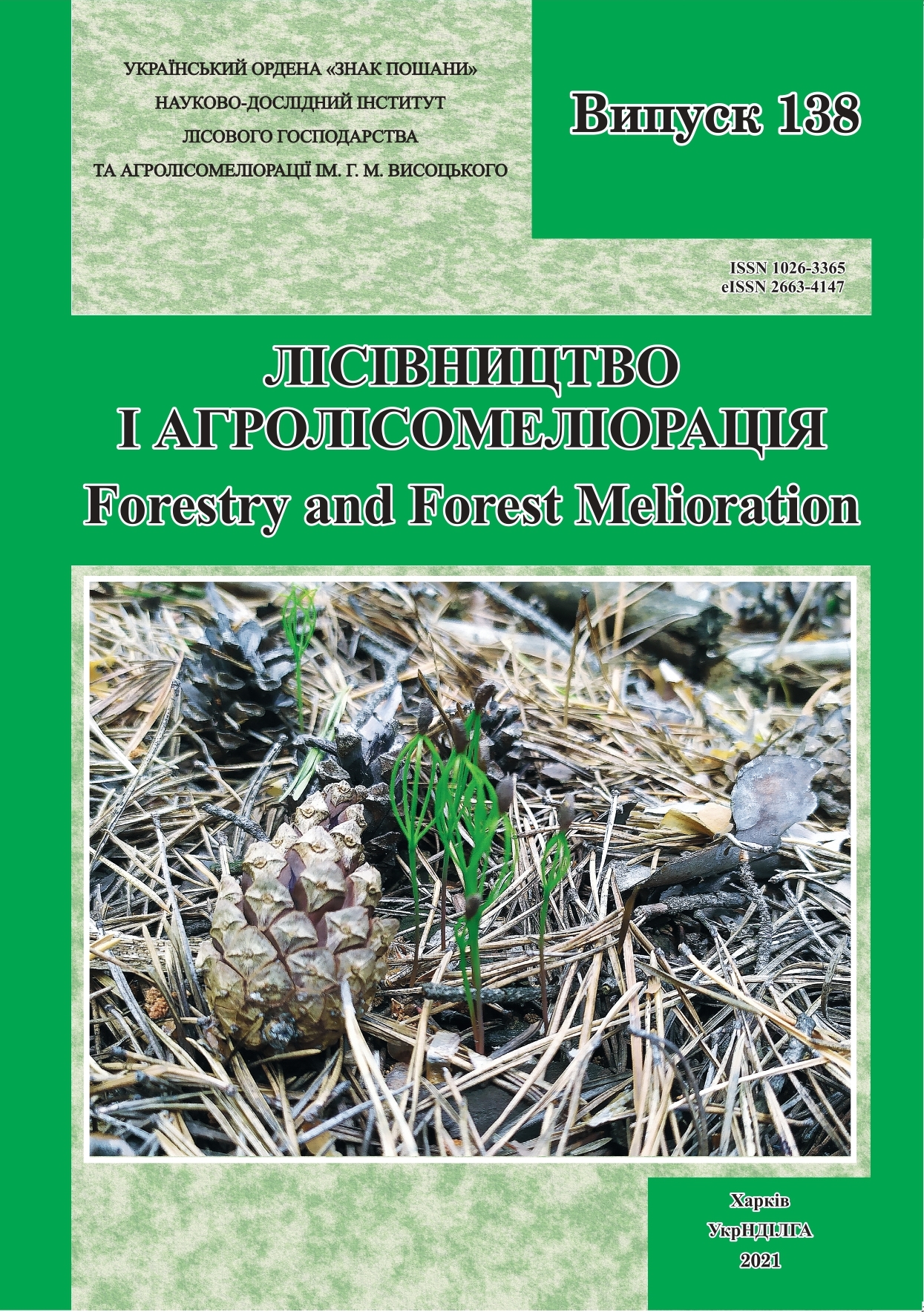Abstract
Introduction
The largest areas and highest levels of radioactive contamination after the Chornobyl accident were detected on the territory of Ukraine, Belarus, Russia, Sweden, and Finland. These territories involve a significant area with forest sphagnous bogs where numerous medicinal plants grow, including Labrador tea (Ledum palustre L.). According to the preliminary data, this species is a high accumulator of 137Cs. Therefore, it is an urgent issue to analyse a multiyear dynamics of accumulation of this radionuclide in phytomass of Labrador tea.
The aim of the study was to investigate the dynamics for 137Cs specific activity in leaf-bearing shoots of Labrador tea in wet fairly infertile forest sites in Ukrainian Polissia after the Chornobyl accident.
Materials and Methods
The research was conducted during 1991–2018 on five experimental plots (EP) in Ukrainian Polissia, Zhytomyr region, Luhyny State Forest Enterprise, Lypnytske forestry unit (EP 11, 13), Luhyny forestry unit (EP 16), and Povchanske forestry unit (EP 15, 18). The type of forest site conditions is transitional from moist fairly infertile type to damp one. Samples of Labrador tea (annual shoots with leaves) were collected in June–July each five years. Soil samples were collected on the depth of 10 cm in places of phytomass sampling.
All samples were dried up and homogenized. 137Cs specific activity in samples was detected: in 1991–2000 by means of the gamma-spectrometer Nokia LP-4900B AFORA with the semi-conductor detector DGDK-100-В3, and later – using SEG-001 AKP-S-150 with the scintillation detector NaI(Tl) –150 ? 100 mm. The transfer factor (TF) was calculated as index of intensity of 137Cs (m2·kg-1·10-3).
Results
Specific activity of 137Cs in the aboveground phytomass of Labrador tea in 2018 was high even on experimental plots with the lowest levels of 137Cs density of ground deposition: it was 2,316 ± 286.0 Bq·kg-1 on EP 13 (24.4 ± 2.97 kBq·m-2) and 2,245 ± 369.5 Bq·kg-1 on EP 11 (26.5 ± 2.39 kBq·m-2). These values significantly exceed State permissible levels of 137Cs in raw material of medicinal plants (500 Bq·kg-1). Results of the research conducted in different years allowed us to obtain linear equations of dependency between density of 137Cs ground deposition and radionuclide specific activity in shoots of Labrador tea: the year 1991 (у = 219.32х – 5,417.4), r2 = 0.99; the year 1995 (у = 186.38х – 3,695.7), r2 = 0.98; the year 2001 (у = 176.99х – 2,872.3), r2 = 0.99; the year 2007 (у = 139.02х – 254.43), r2 = 0.96; the year 2012 (у = 125.31х – 924.79), r2 = 0.99; the year 2018 (у = 84.83х – 47.04), r2 = 0.91.
The research showed that during the study period 137Cs specific activity in Labrador tea phytomass was decreasing. Thus, on EP 13 this index in 2018 was only 32.9 % of the initial number in 1991; on EP 11 – 30.3 %; on EP 16 – 18.9 %; on EP 15 – 15.4 %; on EP 18 – 21.3 %.
In general, during the observation period, the values of the transfer factor significantly decreased: on EP 13 – from 133.1 ± 1.29 tо 95.2 ± 6.76 m2·kg-1·10-3 (by 1.4 times); on EP 11 – from 102.9 ± 11.11 tо 87.5 ± 20.33 m2·kg-1·10-3 (by 1.2 times); on EP 16 – from 225.6 ± 47.48 tо 84.9 ± 5.75 m2·kg-1·10-3 (by 2.7 times); on EP 15 – from 208.3 ± 11.66 tо 69.5 ± 5.83 m2·kg-1·10-3 (by 3.0 times); on EP 18 – from 201.2 ± 22.36 tо 101.1 ± 1.62 m2·kg-1·10-3 (by 2.0 times).
Conclusions
We observed a change of radiation level in forest bogs, mainly due to radionuclide decay and redistribution of radionuclides among the components of biogeocoenoses. Specific activity of 137Сs in Labrador tea shoots in forest sphagnous bogs of Ukrainian Polissia decreased in 3.1–6.5 times during 1991–2018, which can be explained mainly by a decrease in density of 137Cs ground deposition. Furthermore, a decrease in intensity of uptake of 137Сs tо Labrador tea was observed; values of the transfer factor decreased during the observation period in 1.2–3.0 times.

This work is licensed under a Creative Commons Attribution 4.0 International License.
